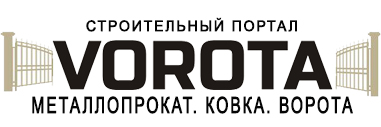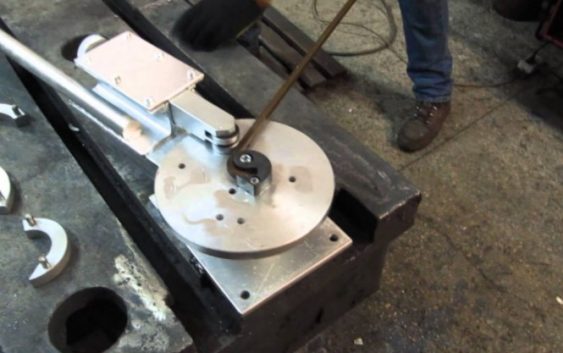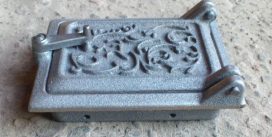Forging - one of the most common ways of metal machining, allowing to make rolling out a variety of metal materials, design and decorative elements. Forged railings and stair balusters, window bars, visors and fence, arbours, barbecues - all of these products always attract admiring glances.
types of forging
Depending on the characteristics of the process metal treating process, forging divided into manual and machine, forging hammers and forging, hot and a "cold":
– Hand forging - metal processing with sledge hammer and. Despite the development of modern technologies and the emergence of high-precision metal-working equipment, hand forging is still used by many blacksmiths, and products, handcrafted, always in great demand.
– Forging machine has a big difference from manual, possible to produce large forgings weight in any amount and at a higher precision. It is produced by a hammer, forging machines and presses. This equipment has long been a reliable tool for the modern blacksmiths.
– Hot forging (and forging a real one else is) It implies required in heating the workpiece to forge the forging temperature, followed by treatment with the hammer, hammer or sledgehammer. Heating of the workpiece is needed to impart plasticity and ductility metal, which makes it quite easy to make the necessary workpiece shape.
– Tek-called "cold forging" – it is essentially the production of any - or decorative elements by means of a stamp or a powerful multifunction machines, without allowing the preform to produce the same type of heating elements, difficult to adapt to any non-standard sizes of future products. Besides, forging conventionally divided into normal forging and art.
Unlike manual artistic forging metal by simply forging
Usual forging of metal - it, in fact, remeslennaya Stats, allows to make beautiful, but the same type of metal. These forgings no individuality. While under the artistic forging refers to the creation of original decorative elements, the most intricate and irregular shapes. To do this, the blacksmith must have not only the experience and professionalism, but also a sense of beauty and taste. Not every artist reaches such heights, but he, who has learned to "understand" the metal, subsequently able to create out of the ordinary process billet works of art.
Equipment and tools forge
If desired, set a blacksmith to learn blacksmithing is quite able to independently, however, for the effective organization of work and the arrangement of their own need to forge a fairly extensive set of tools.
Hammer
One of the main installations in the blacksmith's workshop with different power, varies between 25 kg 20 tonnes and depends on the weight of falling parts. Depending on the energy source is divided into hammers:
– Pneumatic. Used for open forging operations, in rare cases for stamping.
– hydraulic. Used for hot forging, straightening and sometimes calibration.
– steam. The most versatile installation is equally applicable for forging, and punching. Thus, depending on the design of the primary energy source - compressed air may serve not only to lift the falling parts, but also give them the acceleration, enhancing blow.
Horn Forge
GornObyazatelny element forge workshop, if planned manufacturing elements of a free metal and artistic forging. By execution type horn is divided into:
– open hearth (stationary) a metal frame with a molded countertop trough-shaped and mounted lance for injecting air through the middle. Inside the tiled hearth of refractory bricks.
– Closed (stationary). Is a chamber made of refractory bricks, mounted on a metal frame, a working window for blanks, lance and the furnace hatch. The top of the exhaust hood is located and the flue for discharging products of combustion. This execution has certain advantages - significantly reduced fuel consumption, required for heating the metal, It provides the necessary fire safety installation. On the other hand difficult to handle the large-scale workpieces.
– portable (open). have riveted, svarnuyu or lituyu staninu with vыemkoy, lined with refractory bricks. Lance - cast with small slits for the prevention of air pollution.
Fuel for the hearth may be coal, coke or gas.
Nakovalьnя
The main supporting means blacksmith, manufactured by casting from high-strength steel st.45 A followed by heat treatment. From this tool by weight 1 to 300 kg depends largely on the accuracy and quality of forging fabricated metal. Depending on the design of the anvil is:
– hornless. Is used to perform the simplest operations - distribution of material, flexible products and a variety of simple works.
– unicorn. To the list of the above-described operations, you can add bending bars and the strip material at an acute angle, Unrolling and welded ring blanks.
– two-horned. When the tail stock on the anvil can be performed flexion angle 90 degrees and edit rectangular blanks.
-Shperaki - optional accessory, is inserted into the hole on the tail of the anvil. It used to make small blacksmith's work.
Hand tools for the art of forging metal
Most of the elements of art forging manufactured by forging, bending, twisting and winding, therefore the tool must be appropriately. need:
– hammers;
– sledgehammers;
– teeth;
– mandrel for fixing the blanks;
– backing tool;
– pliers;
– patterns (you can make your own or buy from a manufacturer of hand forging equipment).
With these tools are made separate decorative elements, of whom subsequently going fabricated metal products. Welding can be used:
– or argon arc welding machine;
– semi-automatic welding of carbon dioxide medium.
Product assembly is preferably carried out on a special table, boards made of chipboard and, worktop compulsorily covered steel sheet.
Stripper forged articles after welding
After assembly, welding joints must undergo sweeping. This will not only give a finished look metalware, but also improve the reliability of the connection. Depending on the metal used may require stripping:
– Bulgarian;
– circle roughing;
– grinding;
– wire brush;
– sandblasting.
Finishing processing stage products of artistic forging:
Forged vetkaChtoby give the product of artistic forging an even greater aesthetic, it is often painted with paints primer precoated means. It is also possible to artificially age the metal products with a special paint - patina.



